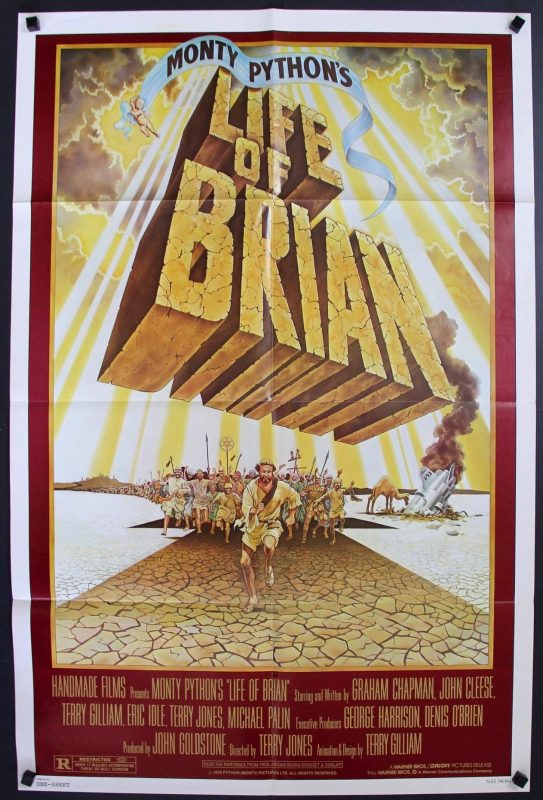In 2017, James Bridle published Something is Wrong on the Internet.
Sensationalist, and three times longer than it needed to be, the essay hit on something so stark and repellant that it sent shockwaves across the internet. Reading it made you feel like you were lifting a rock on a creepy-crawly world of SPIDERMAN ELSA POOP HITLER FINGER PUPPET SINGALONG videos.

Bridle wasn’t the first to notice ElsaGate (Geoff Weiss on Tubefilter wrote more benignly about it, some months earlier), but he went unusually deep into the phenomenon, connecting it to other ideas swirling in the atmosphere at the time.
He said the thing that a lot of us had always felt: Youtube had shapeshifted into a dragon and you were a goddamned moron if you let your kid on it.
To summarise the essay’s main claims:
Youtube is broken. A swarm of bottom-feeding channels use either AI or low-cost third world labor to spray thousands of cheap, algorithmically generated videos into your child’s Youtube feed.
These videos (which typically work along a formula such as “[copyrighted character 1] + [copyrighted character 2] + [keyword keyword keyword]”) are often surprisingly nasty. They involve characters pissing and shitting and getting pregnant and giving birth and dentists sticking needles into Peppa Pig’s gums and Marvel heroes getting burned and buried alive and low-key pederastic shit and actual alleged child abuse, along with other things that should probably inspire the creators to go back to school and retake Remedial Humanity 101.
These aren’t satire videos like Happy Tree Friends or “Cupcakes”-style MLP videos (which are clearly meant to be watched by adults). They’re targeted at children. But why? And by whom? ElsaGate videos are run by faceless brands called stuff like DisneyToys4Kids (it’s hard to make up fake names without stumbling upon a real channel), with no hint of who’s behind the curtain.
How worried should we be? And what should we do?
Bridle’s diagnosis is unclear and verges on being keyword salad itself. Technology? Capitalism? Money? It’s as much a roil of generational anxiety as it is an essay. But six years affords some clarity, and I think we can speak more calmly and definitely about the trend, which was both less alarming and more alarming than at it first appears.
But you cannot understand ElsaGate without first understanding Youtube, and the ways it is completely fucked as a site.
I will be as brief as I can.
Problem #1: No One Knows What Youtube Is Actually For
“Uh…videos?”
No. Not any more than a library’s purpose is to store paper.
Videos are the format, not the content. Youtube is relatively unique in the social media space: unlike, for example, Twitter or TikTok (short-form content), or NewGrounds (flash animations and games), Youtube has no direction, no “this is what we do” elevator pitch.
The site will happily host…
- old BBC shows
- Call of Duty trickshots
- corporate training videos
- vlogs
- political propaganda
- 10 hours of noise
- every time Donald Trump has said “China”
- playlists of arrest videos where the arresting officer is female
- whatever the unholy Christ this is
All of it just gets regurgitated in a baby-bird splatter on Youtube. It’s a tabula rasa, an asylum wall for the internet’s most insane people to paint with feces.
In 2022, Jason Scott of the Internet Archive put out an impassioned plea to not upload masses of random Youtube videos to the IA. They’re such a hodgepodge that, from an archival perspective, they’re worthless. It’s like loading up a truck with six tons of rick-rack and dumping it in front of an antique store. Sure, maybe there’s valuable stuff in the pile. Who’s got time to sort through it?
(I will note parenthetically that this wasn’t always the case. Early Youtube had more of a focus on home-movie type stuff. “Me at the Zoo” set the tone. Just people uploading things that meant something to them, and maybe their friends. There were no sponsors. You couldn’t even run ads until 2007. It was a site for sharing experiences. The site’s old slogan was “Broadcast yourself”.)
This matters, because it makes ElsaGate difficult to diagnose as a disease.
There’s no “normal Youtube” that ElsaGate stands apart from. Youtube is not a healthy body and ElsaGate is not a cancer. It’s all part of the same jumbled, confused collage: video creators bashing memes and trends together and hoping views emerge from the rubble.
ElsaGate isn’t a shoggoth from the outer dark, it’s Youtube working as intended. When your site’s ethos “everything and everything!” you have to actually expect everything and anything.
Problem #2: Algor Rhythms
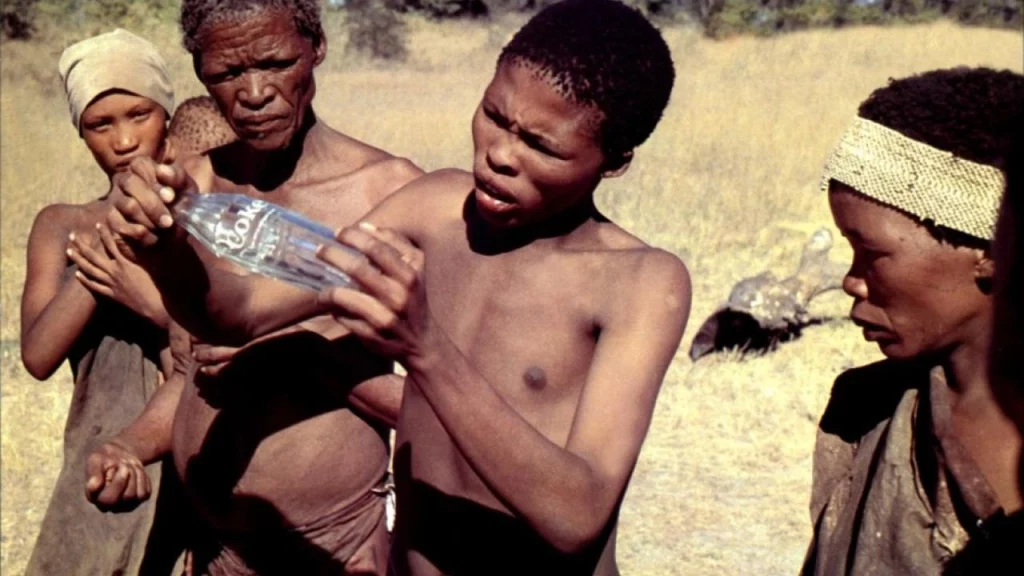
In 1980, a movie was released in South Africa called The Gods Must Be Crazy.
It’s about a tribe of San bushmen who discover a Coca-Cola bottle that someone flung out of an airplane. This strange artifact (from a world they cannot understand) throws their peaceful lives into turmoil.
In other words, it’s basically a movie about Youtube’s algorithm.
Algorithms control everything you see (and don’t see) on the site. They act both as red carpets and as guard ropes, shuttling viewers toward certain videos and away from others. They are extremely sophisticated: even if you don’t tell Youtube who you are, your on-site behavior will classify you with shocking precision. It hardly makes sense to speak of “Youtube” as a singular entity. An eight-year-old girl who likes horses and a forty-year-old man who likes Chevys will basically experience two different sites.
(Again, this was less true in the early days, when Youtube had more of a monoculture. Everyone knew who brookers and lonelygirl15 were. Everyone had seen Smosh lip-sync the Pokemon theme song. This sense of shared community vanished as the site exploded in size and the algorithmic prison walls went up. Today, a content creator can have tens of millions of views, and if they’re in your algorithmic outbucket you’ll never know they exist.)
But the algorithm doesn’t always work. Occasionally a video breaks containment, and an unsuspecting audience will have a Coca Cola bottle go BONK on their head.
APPLE.MOV is a good demonstration of how this works in practice.
It’s a fan-made My Little Pony parody where Applejack eats too many apples, and undergoes a half-gross, half-funny transformation. The video, with its edgy cussing and adult humor, was not supposed to be watched by children. But an audience of children found it nevertheless. Read the comments!
It feels really satisfying when you rewatch something of your childhood and then understanding the adult jokes and the words they used
fun fact: about 45% of viewers saw this as a toddler with zero idea of what they were watching, then came back for nostalgia
I was like 9 or 10 lol
Revisiting my “Very good” childhood
How did they see this age-inappropriate video? I don’t know. Perhaps a kid clicked a brightly-colored thumbnail in his recommends. He found it mesmerizing, and sent it around to all friends. A positive feedback cycle kicked off, where the Youtube algo thought “hey, kids like this! I’d better recommend this to as many kids as possible!”
This kind of algorithmic misfiring happens a lot on Youtube. This confuses things, because a lot of videos that are considered “ElsaGate” just…aren’t. They’re adult-oriented videos that fell on the wrong side of the containment fence.
A darker example is this infamous video, where Peppa Pig scrapes bacon off her arm with a potato-peeler…
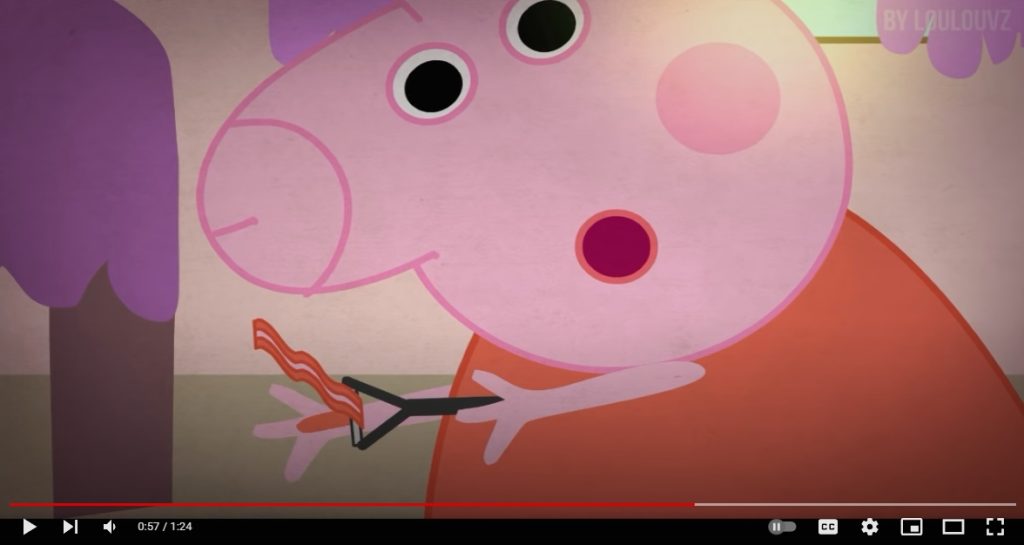
…this looks like ElsaGate, but it isn’t. It’s a work of dark comedy that’s attempting to shock and unsettle. The creator, LouLouVz, has taken pains to clarify this in the video title.
“Peppa Pig and the Bacon Parody (NO FOR KIDS)”.
Needless to say, this hasn’t stopped Youtube from recommending it to kids by the truckload. Beneath the cut (literally), you read the same comment echoed 20,000 times. (Some Spanish comments were translated via Google.)
This scared me as a kid a lot!!!
this video traumatized tf out of me
I remember seeing this when I was about 5 years old and I was traumatized XD
My child hood is long dead now
This animation messed up my psyche in 2015
Yes, it’s clearly bad that children are seeing this stuff and being traumatized by it.
But it’s not LouLouVz’s fault! He/she did not sign up to be your child’s babysitter. Not every video has to be child-friendly. A better idea would be to get annoyed at the Youtube algorithm, which apparently thinks (or thought) that any video starring Peppa Pig should be yeeted into your child’s personalized feed without delay.
This makes it harder to take remedial action against ElsaGate. A policy of blanket removal would mean a lot of innocent videos get caught in the crossfire.
ElsaGate, in its truest form, refers to an exploitative ecosystem of weird, shoddy, creepy videos designed to milk views out of children. But we also have to be clear about what ElsaGate isn’t: the definition doesn’t extend to “any video where cartoon characters do something scary or weird.” Parodies exist. Transformative art exists. We have to allow space for them. As LouLouVz would put it, some things are NO FOR KIDS.
Compounding this is another issue: nobody can agree on what content is kid-friendly. A lot of ElsaGate-type content involve characters getting pregnant and giving birth. Yikes. What group of sickos would expose children to something like that?
Well, Mattel would. In 2002, they released a pregnant Barbie.
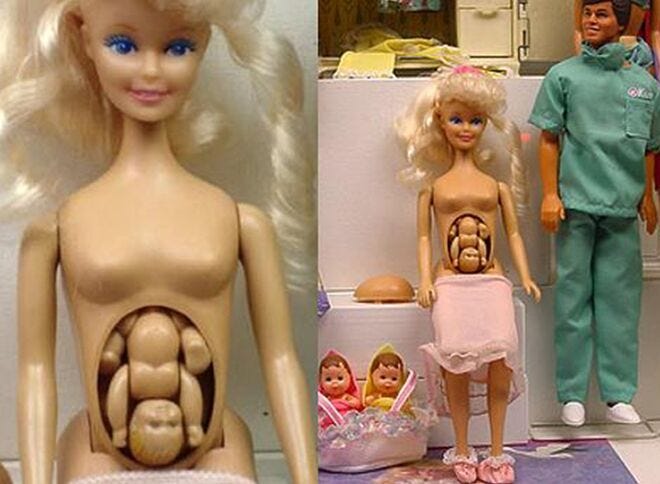
So as you can see, the lines get blurry.
But with that said, ElsaGate is clearly a real thing. Where did it come from?
ElsaGate started as an outgrowth of unboxing culture
ElsaGate began, as far as I can tell, with the channel DisneyCarToys, which on August 30th, 2014 uploaded “Frozen Elsa Dates Spiderman” (re-up).
Unlike the hundreds of later channels, we know who owned DisneyCarToys: a content creator called Sandra Johnson (right).

She made a range of videos: mostly toy unboxings. She ran into the same problem that most unboxers do: it doesn’t take very long to open a box. She needed ways to pad out the video’s running time.
Once you’ve taken a toy out of its wrapping, what do you do with it? Maybe play with it a little on camera, right? And do a voice? And if you have a second toy, maybe they can interact, or go on a little adventure together…
Her audience seemed to like these skit videos. As time went on, the DisneyCarToys pivoted toward them. Then came the fateful day when she mashed up Elsa with Spiderman. The video blew up, garnering 36 million views and 7,800 comments. That’s small beer next to later ElsaGate videos, which would routinely rack up multiple hundreds of millions of views (although this might be illusory, see below) but it was huge for Johnson’s channel.
Why did she pick these two characters? Probably for no other reason than because they were famous. Disney’s Frozen and Sony’s The Amazing Spider-Man 2 had recently come out, and discounted merch glutted the marketplace. Elsa was about to become the avatar of a small cultural moment. Verily, hers was the face that launched a thousand shits.

The corporate, toy-focused nature of ElsaGate is as dystopian as any of the disgusting content. It’s a perfect metaphor for how Youtube (and the internet) works. It’s the wild west, baby! A place to let your freak flag fly! Oh, and you’ll only get views if your video includes famous branded Disney characters.
Soon other channels began ripping off Johnson’s hit (as did Johnson herself), and the trend was cooking with gas. The breed of unboxing-derived videos rapidly mutated, and darker, edgier strains began to appear.
This feels almost like “fuzz testing” (in hacker slang). Just lots of channels manufacturing lots of content, with little variations, and seeing what made it past the algorithm. The answer was “a lot”: the Youtube algorithm is surprisingly stupid, particularly if you bury adult content in the middle of a video that is otherwise bright and colorful.
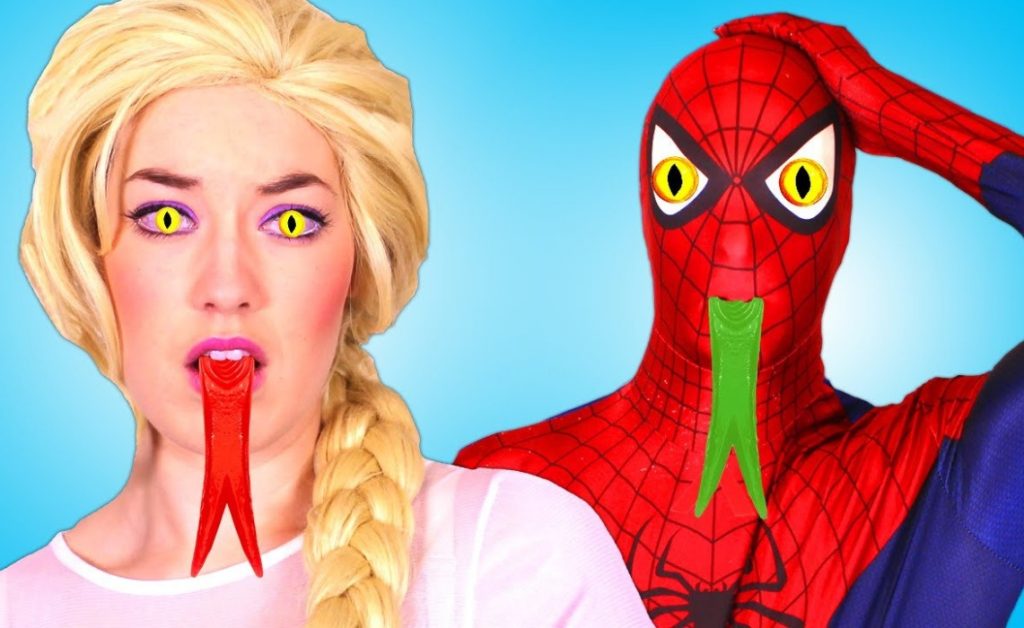
Webs and Tiaras was the goliath in the ElsaGate space. At its peak in 2016, it was a top 5 channel on Youtube, and raked in half a million dollars a month. It exhibits mild versions of all the classic ElsaGate pathologies (syringes and marriage and pregnancy), but at a James Cameron-sized scale. This was about as big as big could get.
The channel was so unnervingly popular that people started to speculate about the authenticity of their stats. In May 2016, Ethan and Hila Klein discussed an Webs and Tiaras affiliated channel, which had scored an incredible 33 million views on their very first video. Nope, nothing to worry about here. Seems legit.
Are they Machine Generated?
The impression you get from Bridle et al is that there’s some kind of AI or automated script cranking them out. Here’s Vadakkus:
Predefined software generates these videos by populating pre-defined templates with auto-generated characters, then gives them word-salad names of most frequently searched keywords, uploads them to YouTube, uses click farms and bots to purchase views and comments, and you have Elsagate. Content quality simply does not matter, given its audience. If you look closely, those videos all feature the same things arranged in different permutations and combinations. What we are seeing is industrial-levels of automated mass-content production, impossible to control, curate or censor. It is terrifying to think what we have created.
Eh…I don’t think this really ever happened that much.
Granted, I haven’t watched all of ElsaGate (because I don’t have enough Thorazine in the house), but let’s take a gander at one of the OG ElsaGate channels, TonsofToyz.

Here we see all the usual depravity: randomly CAPITALIZED Engrish TITLES, cartoon characters mashed together in a Punnett Square from hell, terrible voice acting, and gross themes involving surgery and medicine. You can’t make this up. Unless you’re TonsofToyz. Then you did make it up,
But the videos are definitely not machine generated. They have individual scripts, unique camera angles, and so forth. They have a human touch.
What about the 3D videos, such as BURIED ALIVE? In theory, you could automate Premiere Pro to spit out endless algorithmic variants, swapping assets in and out depending on what’s trending. But I’ve never seen anyone actually do that. The animations and camera angles are all hand-keyed. It’s probable that the videos are so easy to crank out that it’s not worth the effort.
There are a couple of channels (like the one screencapped below) where they’re obviously recycling the same video with some assets changed (note the identical runtimes on several of the videos), but it seems fairly rare.
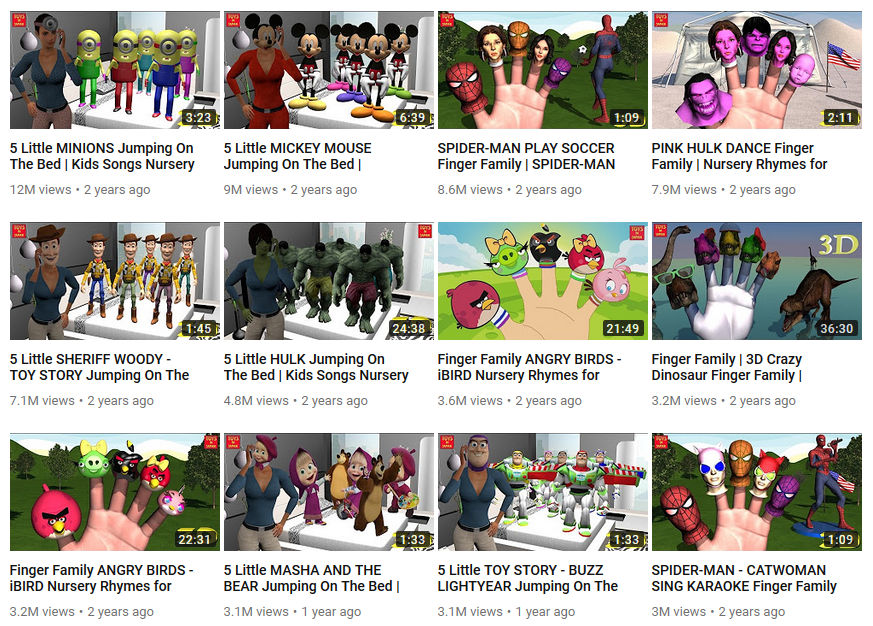
Don’t get me wrong. The videos are as crappy as it gets, however they’re made. If I had a choice between a childhood filled with molestation and a childhood filled with ElsaGate, I’m not saying I’d pick molestation, but I’m also not saying I wouldn’t. But ElsaGate videos are made by actual humans. That might be better or worse, depending on your point of view.
That said, maybe they’re not being watched by humans…
Were the videos viewbotted?
Right from the jump, the sheer popularity of ElsaGate videos staggered many commenters. How was this terrifying horseshit getting tens of millions of views? You didn’t even need to look up to the content window to wonder if shenanigans were afoot.
While I hesitate to accuse any of these fine, upstanding channels of breaking Youtube’s TOS, there’s some evidence that the bigger ElsaGate channels were paying for bulk views and subs.
Firstly, their view/comment ratio was way off. A video will normally have 1 comment per thousand views (it can vary based on audience and subject matter). Yet ElsaGate videos with millions of views would have only few dozen comments, mostly gibberish or foreign languages.

…But that could be explained by the fact that the Youtube Kids app doesn’t let you comment or sub. The inflated viewcounts could be the work of children watching the videos hundreds of times on repeat.
But eagle-eyed Redditors soon noticed other discrepancies: such as the way the views weren’t increasing in an organic way.
So Toy Monster, with 1 mil subs, posted a new video about 3 hours ago. 158 views. Seems legit. In comparison, there are thousands of views 15 minutes after a new Ethan and Hila video comes out with half the amount of subs of Toy Monster.
rietstengel
…or the fact that the views came from countries noted for clickfarming.
I watched the last video where he says they provided “proof” that their views are legit. I used to work at a company that managed companies social media accounts.
So the guy says that they showed that the majority of their views come from Vietnam and other small asian countries, and I don’t know if Youtube is the same as Facebook, but Vietnam, Indonesia, and other small asian countries is where all the “Click Farms” are so it’s people with thousands of fake facebook accounts liking stuff to boost a Facebook pages amount of likes.
the_cunt_muncher
Also, the likes/stats were always disabled in the Webs and Tiaras videos – an inexplicable thing to do, unless you’re trying to hide evidence of wrongdoing.
A Youtuber called Zachzy Games went deep into the viewbotting conspiracy. He even made contact with the owners of Webs and Tiaras (they denied the viewbotting claims and even apparently sent him evidence, which he disbelieved but couldn’t refute).
Enragingly, his videos are now gone (as is virtually every ElsaGate video in Bridle’s essay). This is de rigeur for online research work, where huge chunks of valuable history just disappear at any moment.
Paying for views is a good way to manufacture legitimacy. If any parents started to suspect that their kid was getting eaten alive by a demon singing a puppet finger song, they might reassure themselves with a glance at the view counter. “Hey, how can a video with fifty million views be that bad?”
But viewbotting isn’t the whole story. Many ElsaGate videos show a normal pattern of activity. This one has 3k comments on an 80m view video, which is a low but believable number for a video that’s mostly watched by children who either can’t type or don’t have Youtube accounts. I think this stuff is genuinely popular.
ElsaGate research is a real rabbit hole, and you can easily find your way into some of the strangest and most disturbing places on the internet.
I’m not talking about the videos. I’m talking out the research movement.
ElsaGate investigators are completely fucking bonkers
As Nietzsche said (probably), when you gaze into the FROZEN ELSA SHITTING JOKER NEEDLE PREGNANT HOLOCAUST video, it stares back at you.
A lot of people have made ElsaGate their identity, to an unwholesome degree. To them, it’s an “ARG”: a puzzle to be solved. But not only do they fail to understand the mechanics behind it, they don’t even seem to want to understand. They want ElsaGate to be this creepy sinister creepypasta; something far more mysterious and evil than it actually is.
Their rhetoric has a “save the children!” tone, with all the PizzaGate that entails. In fact, the movement basically is PizzaGate. It was incubated on the same chanboards, and promulgated by many of the same people. Read any of the prime 2017-era ElsaGater threads, and they’re full of references to Hillary, Comet Ping Pong, and Seth Rich. To them, it’s all part of the same picture.

Some of these people are just…not right. For a representative example, read Elsagate Pedogate the many faces of Youtube (I swear that’s the title), by readwipedandblew (I swear that’s his name). It reads like a max G force descent into unmedicated schizophrenia.
This is by far the most dangerous issue I have come across to speak on. What I am about to reveal may put my family and, myself in danger of character assassination or worse. I state for the record that It was my hand, mine alone who harnessed the initiative, intention and willpower to make this go viral but, others had noticed this and posted on this only to have it removed before me. Our team built on their research and we hope that law enforcement and the citizen journalists can build on this as well so that we all may become informed decision makers in the future. […]
…and so on. You get the idea.
He links to other 4chan threads, where “researchers” pick apart the ElsaGate videos for clues and breadcrumbs. Many seem obviously unstable.
This is pizzagate 2.0
Strange yt vids for kids with millions of views with encoded messages in comments leading to a possible serial killer and mkultra videos which triggers are objects which get shown in said kid videosIts either a murdering case or another fucking kike tactic where youtube is involved, mkultratactics which get stuffed into the children by these videos
anon
Requesting more videos of this type so I can trigger my latent MKULTRA programming (if any) and deprogram myself
> yes, I did GATE. yes, it was in windowless rooms and I don’t really remember it
anon2
> yes, I have a 135 IQ, occipital bun, multiple near death experiences and head scars, and first girlfriend who had connections to a shady globalist organization
> yes, these days I’m just another mentally fucked STEM-cuck working for a prestigious Jew-controlled research organization doing routine non-classified work
Training, research and development in remote control heart attack weapons. They feel they must sacrifice a few to understand the weapons capabilities. SATAN (silent assassination through amplification of neurons) is the program to try and kill the target through car crashes, heart attack, remote neural attacks, etc. Those people who are successful remote heart attack targets or written off as crazy are not counted The CIA & DoD Hive Mind Teams are collecting kill probability ratios, such as by inducing a heart attack, stroke, heart disease, etc., in so much as I am constantly assaulted by the SATAN system which means I am EEG heterodyned. The technology depends on Timing & Location so I am satellite tracked anywhere in the world. They can actually cause vasoconstriction and increase my blood pressure This is not paranoid delusions. The U.S. DoD has published documents that show that they mapped out the sensory and neural pathways of the brain to cause remote control heart attacks, etc. If you know how the effect works and you have Beta Blockers or Valium on hand, it will be impossible for them to accomplish it.
anon3
The jew is not invincible. Nanotech is nowhere near as advanced as this guy implies. No you cannot scan brains from space.
This is merely propaganda to try to get people depressed and less likely to revolt.
anon4
In hindsight, it’s probably for the best that the owners of Webs and Tiaras et al kept a low profile. They are playing with the same fire that sometimes gets people hurt or killed (see Mark David Chapman, and Ricardo López).
Like PizzaGate, ElsaGate moved from the chans to reddit, where it gained a veneer of respectability (or at least researchers with sufficient self-control to not invoke the Jewish Question in every paragraph). To this day, a lot of ElsaGaters appear convinced, on uncompelling evidence, that the videos are part of a pedophile grooming network.

And many are still hung up on all the old PizzaGate stuff. You’ll see repeated references to Caesar ciphers.

Such ciphers are basically just a way for people to see faces in clouds, by decoding random keyboard-mashed Youtube comments into different random nonsense that maybe looks like a hidden message if you squint hard enough. (The example above isn’t even that, it’s an ARG by some band that had a bunch of ElsaGaters fooled for weeks).
But still…why do the videos target children?
Well, why wouldn’t they target children? Kids are the greatest audience in the world. They do not skip ads. They do not care about shitty quality. They watch things endlessly on repeat. Look at Youtube’s top ten videos, ranked by views. Six are childrens’ videos!

Apparently, if you do anything on Youtube except make children’s videos, you’re a real dumb-dumb.
Researchers try to bolster their case by linking alleged child abusers like DaddyOFive/FamilyOFive to the trend, even though they had nothing whatsoever to do with ElsaGate (DaddyOFive’s videos were prank-oriented and were mainly watched by teenagers and adults, not toddlers).
Yes, there’s some nasty shit on Youtube. But it’s different kinds of nasty shit. ElsaGate researchers conflate it all into a big monolithic ball of doom, usually centered on some global conspiracy they’ve invented in their heads.
Even within the ElsaGate ecosystem, there are different types of videos. There’s the “crude 3D assets” videos, the “Spiderman costume” videos, the “misunderstood satire” videos, the Friday Night Funkin’/Gacha Life Cringe stuff, and so on. It’s not all the same thing.
Does ElsaGate still exist?
Not really. Youtube is slow and stupid, but when it moves, it does so with the force of a supertanker that needs five miles to turn.
In mid to late 2017 (and following a massive wave of negative press, such as Bridle’s essay), the site rolled out a new set of policies, and began banning accounts, some of which (like Toy Freaks) had millions of subs. Machine learning and human moderators laboriously cleared the ElsaGate crap out of the Youtube Kids app, and channel owners could no longer monetize videos that had cartoon characters acting in adult or inappropriate ways.
Incredibly, it basically worked. All the gigantic 2017-era ElsaGate channels have either been banhammered, abandoned by their owners, or have bled significant amounts of viewership.
Let’s look at that Geoff Weiss article, which lists some popular channels, and see where those channels are now.
- Webs and Tiaras: banned.
- Toy Monster: videos deleted, channel rebranded
- Superfriends: videos deleted.
- I Love Superheroes: rebranded. New videos get a few thousand views each.
- SuperHero Reality TV: rebranded. New videos get a few hundred views each.
- Toy Family: “This account has been terminated due to multiple or severe violations of YouTube’s policy against spam, deceptive practices, and misleading content or other Terms of Service violations.”
- Dennis Cee: appears to have sold his channel to a NYC-based tattoo parlor
TonsofToyz has been abandoned for three years (its latest videos were getting paltry numbers of views, down from a peak of millions of views). According to SocialBlade, their videos are likely bringing in $0.03 – $0.50 per day. Most other channels have died the same death.
What about DisneyCarToys, the channel that started it all? In 2017 Sandra Johnson changed the name to Sandaroo Kids, and then (apparently) sold the channel to Moonbug Entertainment, which repurposed the channel for a bunch of their shit, such as Arpo the Robot and Blippi. All of Sandra’s early proto-ElsaGate videos have been deleted.
So 2017 was a pretty brutal massacre. You might say that Youtube was the dentist with the drill to ElsaGate’s Peppa Pig.
I should mention the fascinating phenomenon of fake ElsaGate videos. For example, this channel, which sometimes tricks the viewer with lurid and gross thumbnails.

…but when you actually watch the video, it’s the tamest, lamest thing ever (spoiler: the mom’s not pregnant, the kids just misunderstood what she was saying).
ElsaGate is a shadow of its former self, but videos about ElsaGate are a booming market. The investigation is still going strong, and Youtube’s full of videos trying to make the trend seem more alive than it is. Blatant parody videos like LouLouVz = ElsaGate. Porn videos uploaded by spambots with virtually no views = ElsaGate.
Basically, ElsaGate is a corpse. But a bunch of citizen researchers are standing around that corpse, poking it with sticks and shocking it with paddles. “It’s alive! I just saw it twitch! Alive, I tell you!”
Videos for children are still huge (as we’ve seen), but the grosser and sicker ones are a lot harder to come by. It’s now no longer possible to attain the algorithmic ascendency necessary to rack up millions of views unless your content is utterly squeaky clean.
…well, almost. There are some clues that ElsaGate is still with us in spirit.
That Spider-Man video I linked before is mostly unobjectionable, but it does take a couple of really inexplicable turns. It features a child (dressed as Venom, I think?) sitting on a toilet, with loud farting/shitting noises. And then Spiderman pulls his laundry out of the washing machine…including a woman’s bra. This is played for laughs.
It’s a minor part of the video, but it’s a little nod to what once was. ElsaGate is like polio. Yes, we’ve mostly eradicated it. But if Youtube relaxes its immune system, it’ll come roaring back.
(Incidentally, it’s fascinating how the character in this video is clearly not Spider-Man. The Marvel superhero is the alter-ego of a boy called Peter Parker, who dresses in a costume and fights crime. But the video depicts an adult man who apparently wears a Spiderman outfit twenty four hours a day, and does all his activities in it, including going to the bathroom. Basically all of ElsaGate is like that. Aggressive but shallow mimesis. The characters have the names of Disney characters, but behave nothing like them.)
Why are they so popular?
But we still haven’t touched the question at the bottom. Why was it ever popular to begin with?
A lot of the 4chan conspiracy theories (it’s the Jews, it’s MKULTRA) are attempts to grapple with a topic that, on the face of it, seems horrible and inexplicable. This should not be watched by bajillions of children, and yet it is.
Well, I’m afraid the answer is simple.
This is what children like to watch.
Kids are disgusting monsters. We just shut our eyes and pretend they’re not. Boys in particular are obsessed with poop and scatalogical humor and violence and cruelty. Do remember what it was like to be a child? Have you listened to the things they say on the playground? They constantly make jokes about poop and boogers. They’re constantly trying out new swear words, trying to get a rise out of their friends, and pushing the envelope of adult behavior.
I had a friend who would torture action figures by slowly melting them in front of a 2000 watt fan heater, like a real-life Sid from Toy Story. I bet he would have loved those videos of Elsa getting needles stuck into her ass.
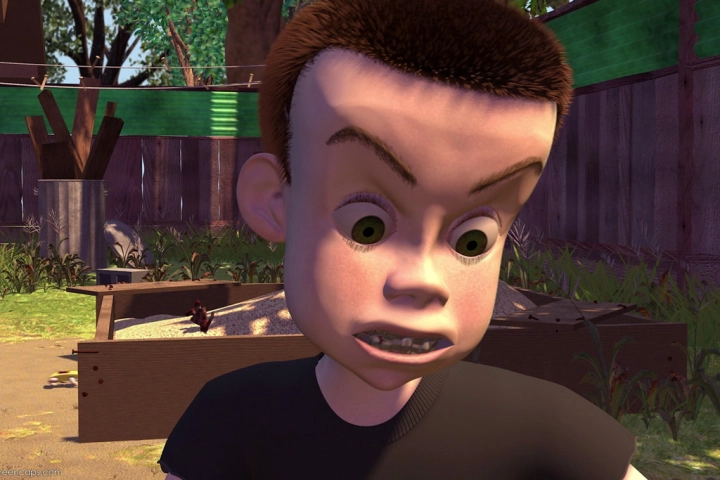
I would argue that somewhere between many and most children, granted unsupervised internet access, gravitate toward ElsaGate-style content. It’s not a big mystery. Children have undeveloped senses of empathy and a strong attraction toward novelty and things that seem “too old” for them. Between Peppa Pig sipping tea and Peppa Pig getting her teeth ripped out, a huge number of kids are going for option number two (in more ways than one).
We never had to worry about this on the legacy TV shows of yore, because gatekeepers stopped children from seeing it. But on Youtube, that isn’t the case. Nobody knows what Youtube is for. And unless a CEO radically restructures the site and turns it into something (I would personally regard this as a terrible move), it’s going to remain a camera obscura, filling with the flickering shadows of our worst impulses. This isn’t some new thing. It’s merely the stripping away of a protective carapace, that we didn’t know was there. This is not some evil MKULTRA conspiracy. It’s the internet’s naked, squamous flesh.
There’s no plot to corrupt your child.
Your child is already corrupt.
(Shout-out goes to the internet, for archiving virtually none of the videos. Bang-up job. Jason Scott doesn’t want Youtube videos on the Internet Archive, but I sure wish they were backed up somewhere. I swear that every time I blink, another epoch of human history disappears down the memory hole.)
No Comments »

